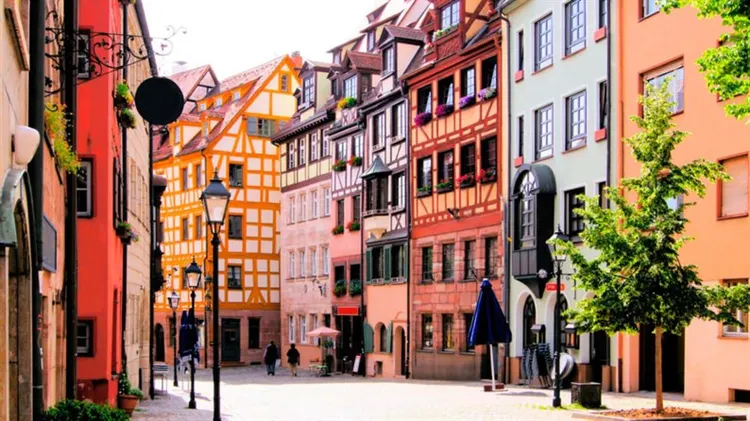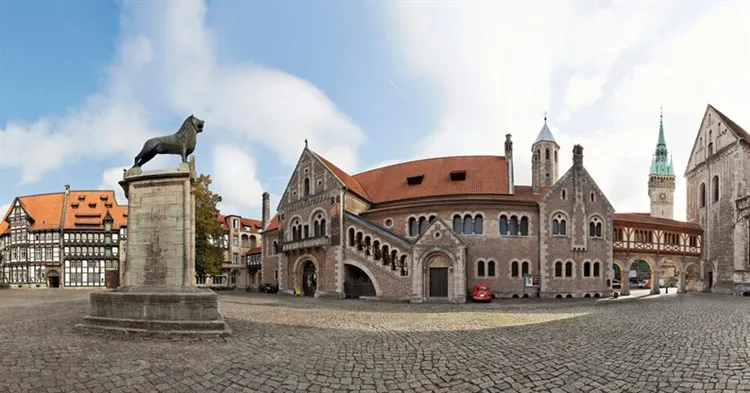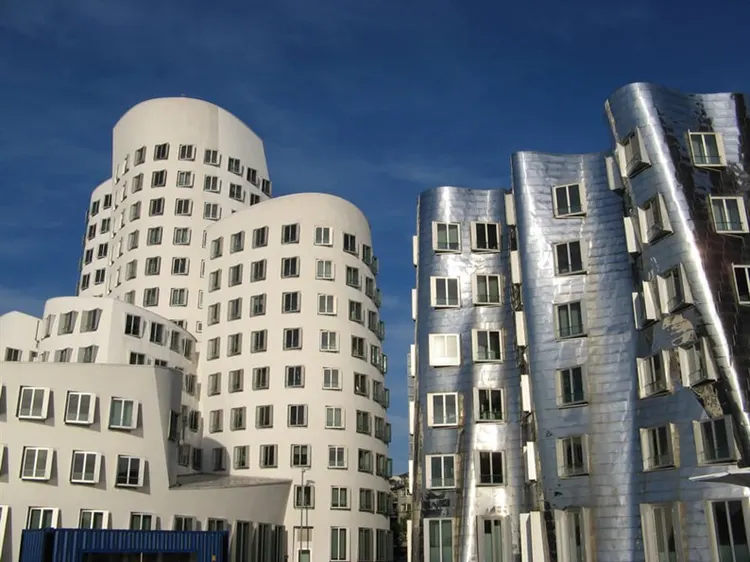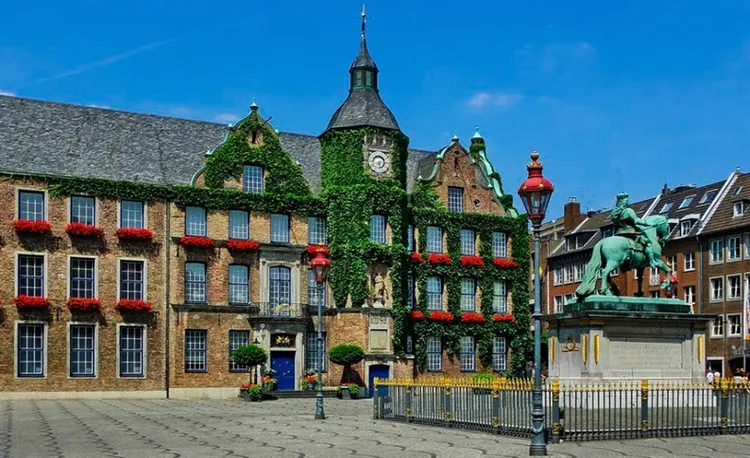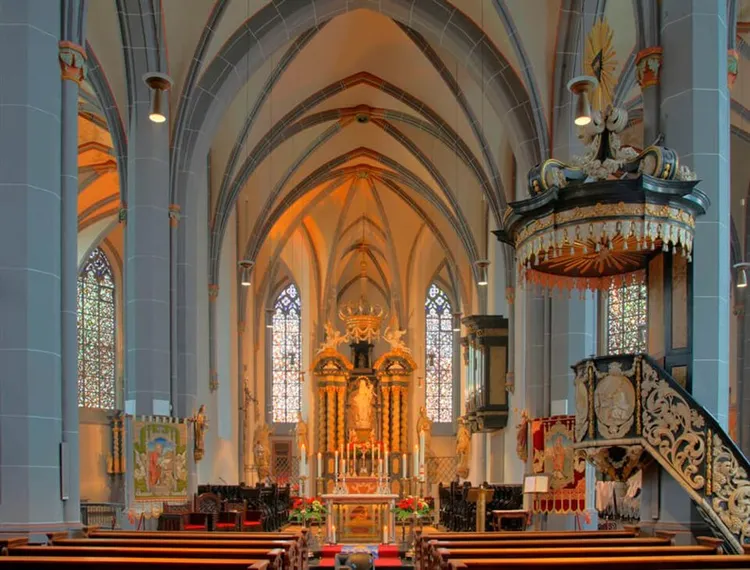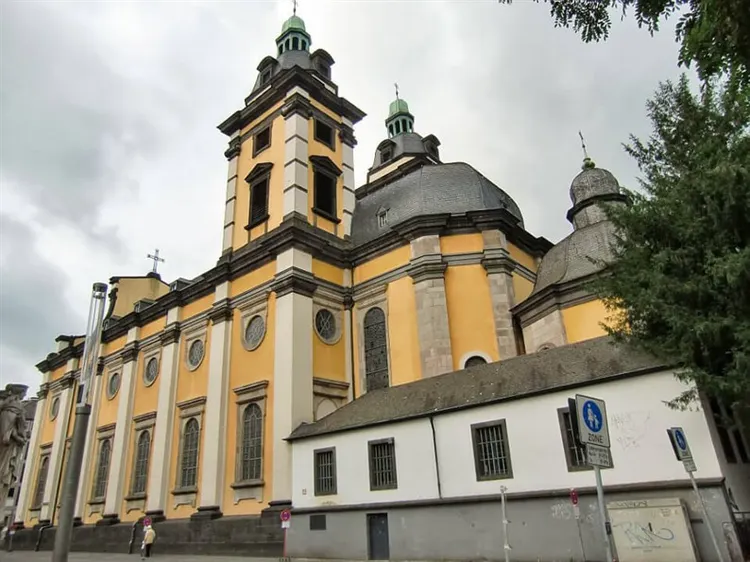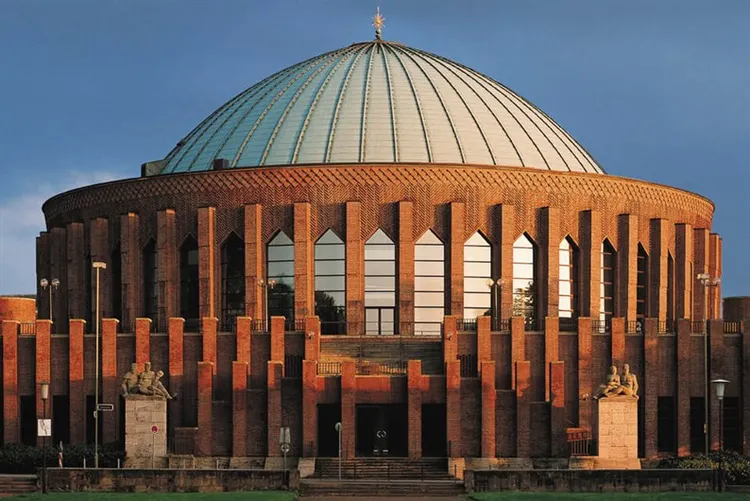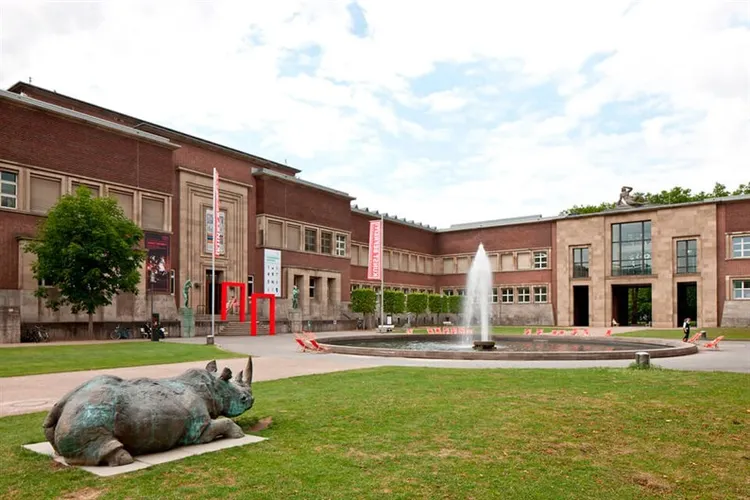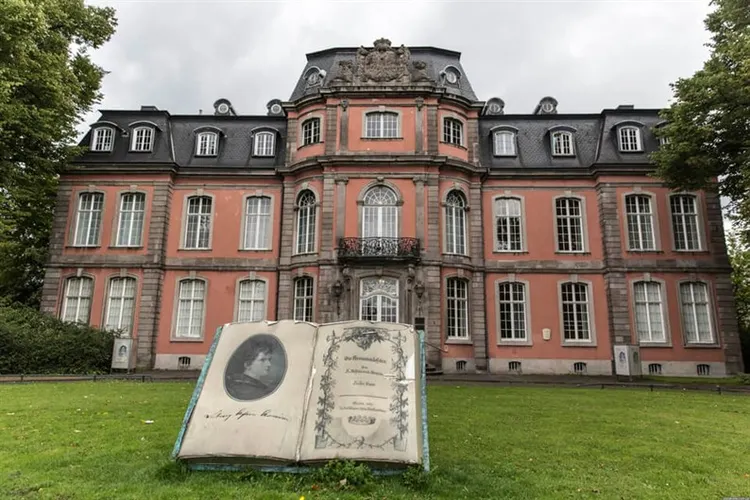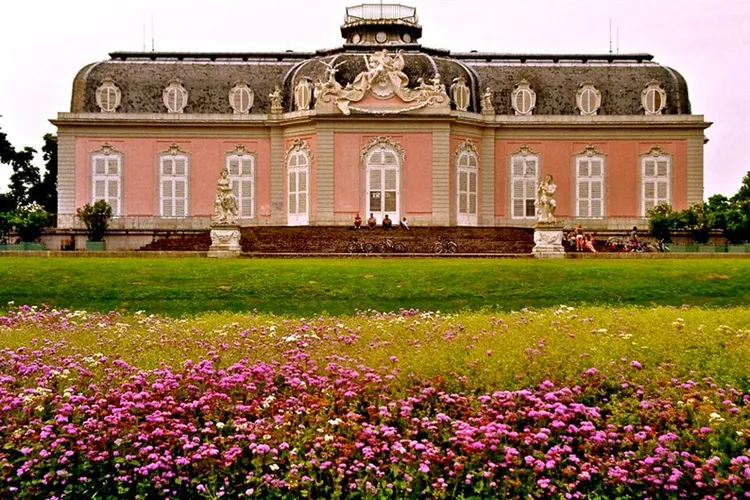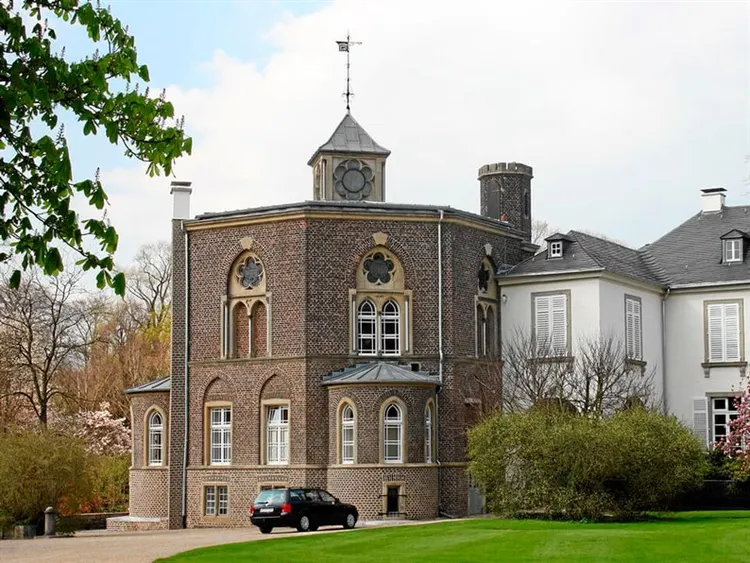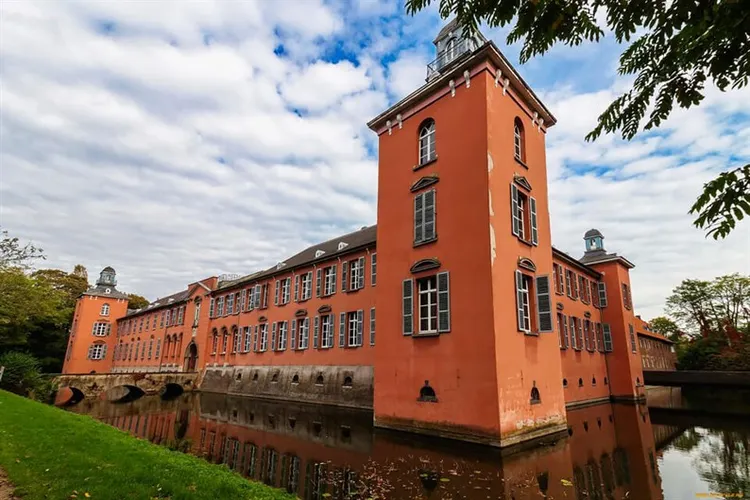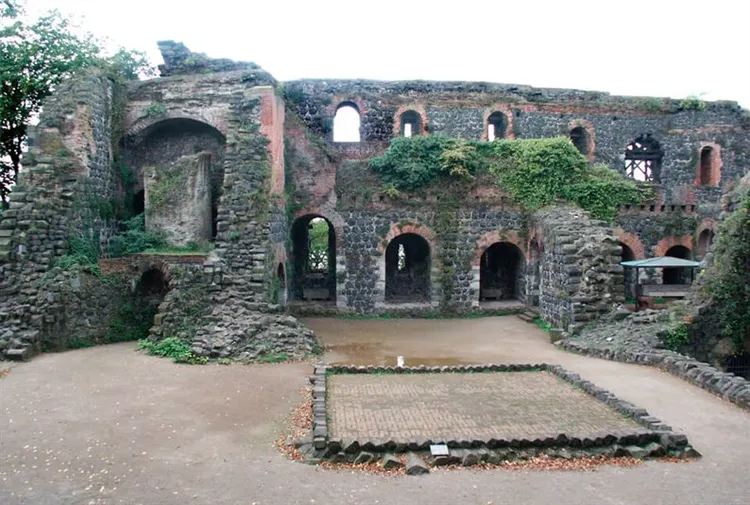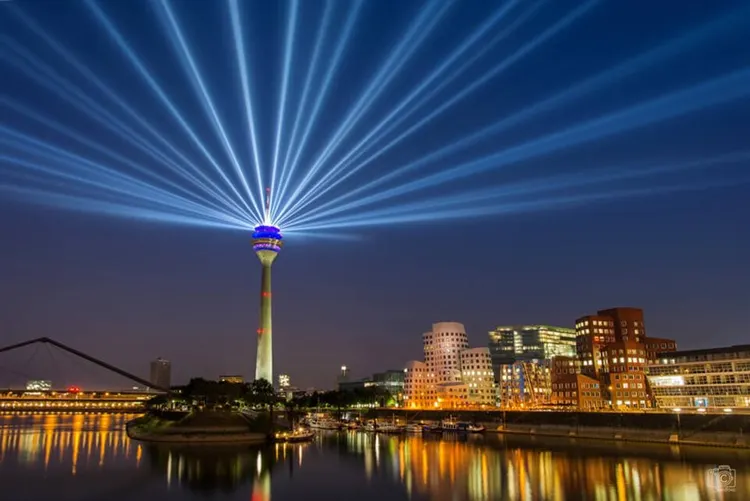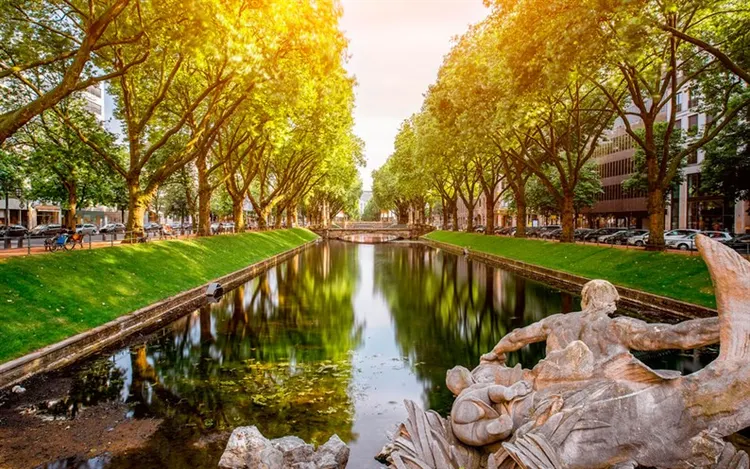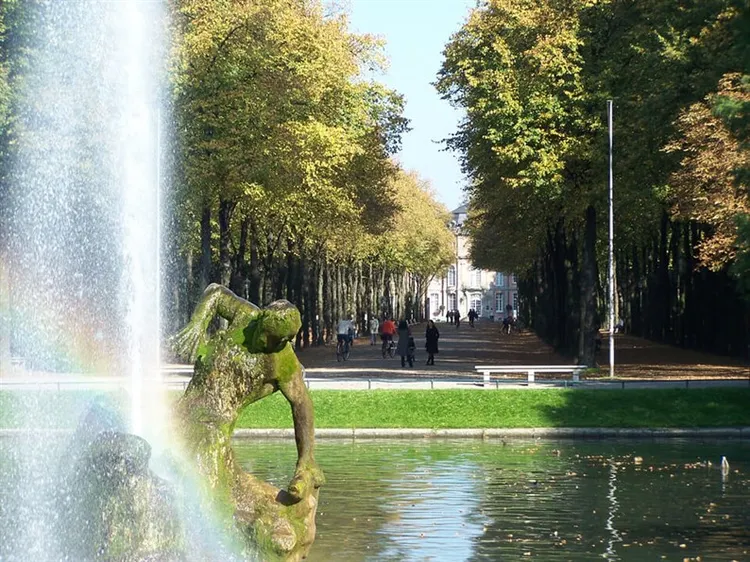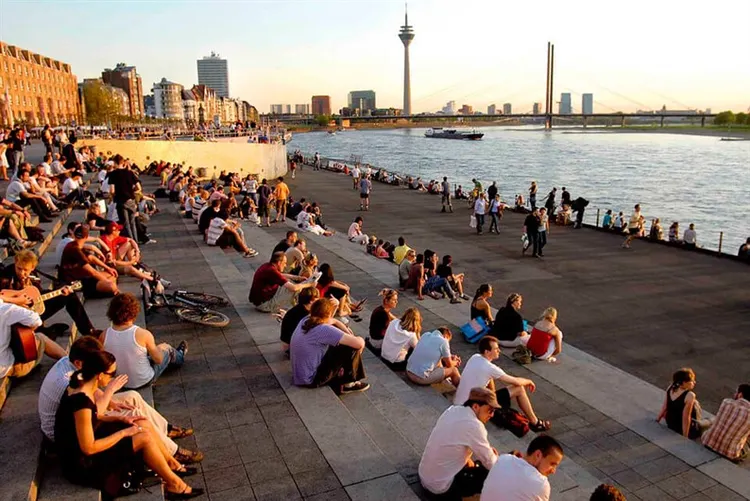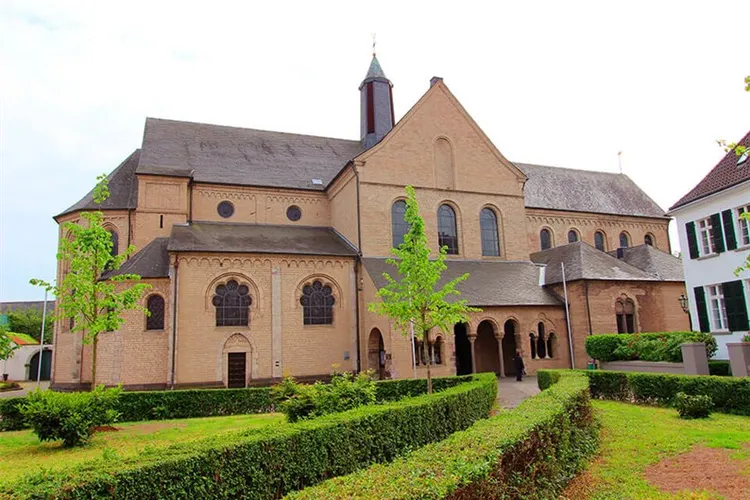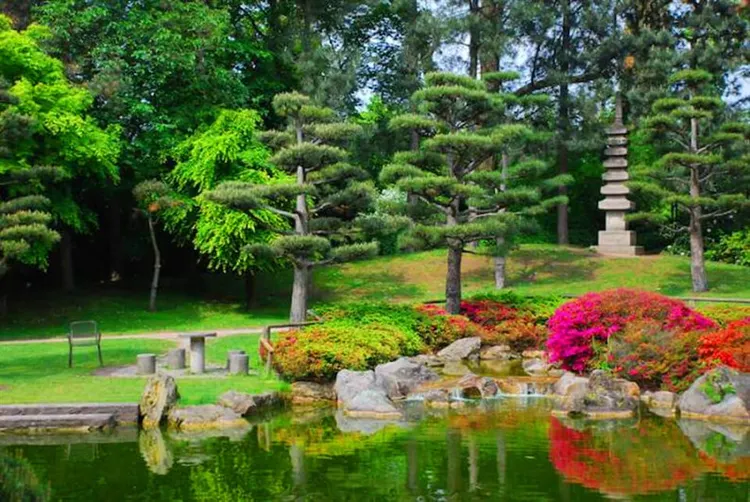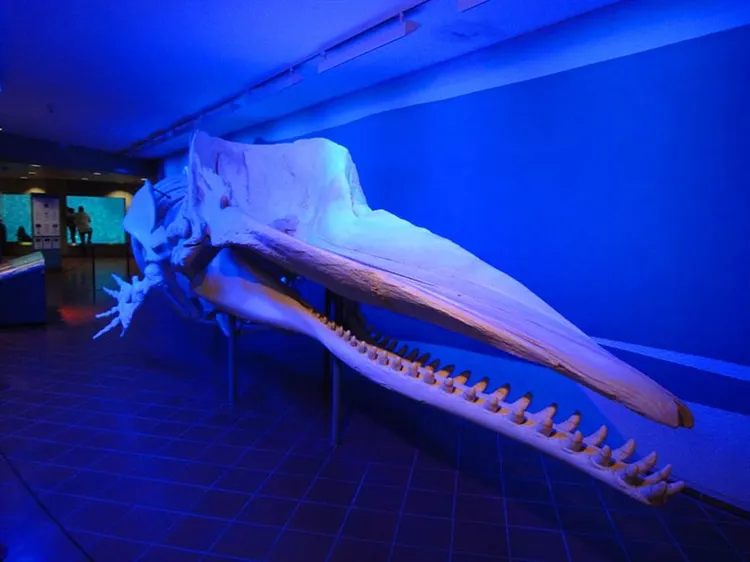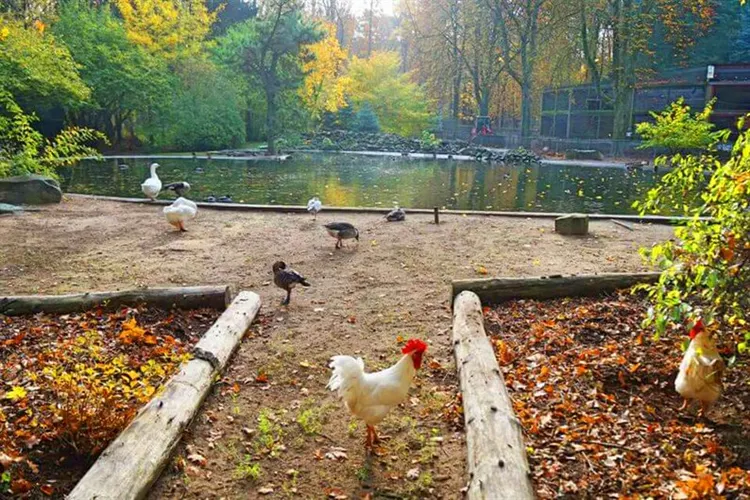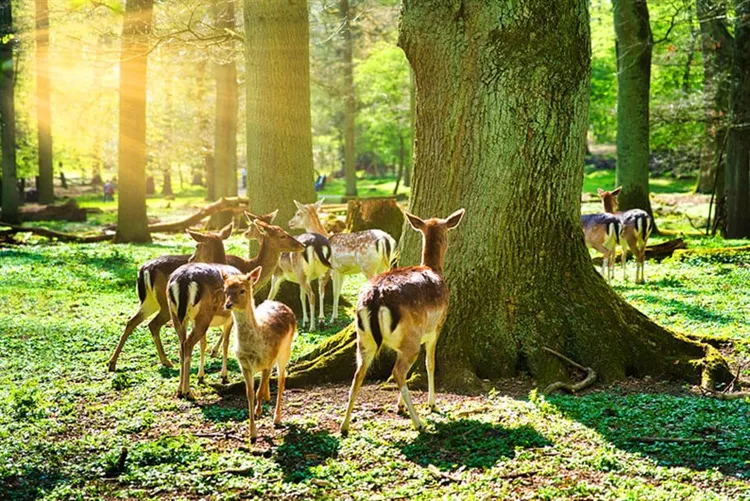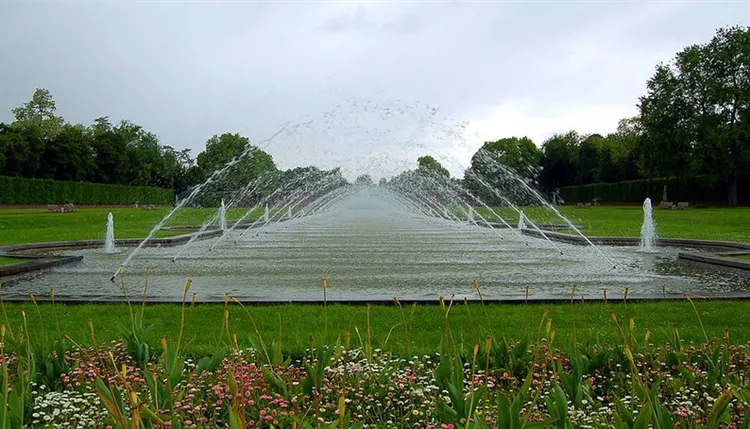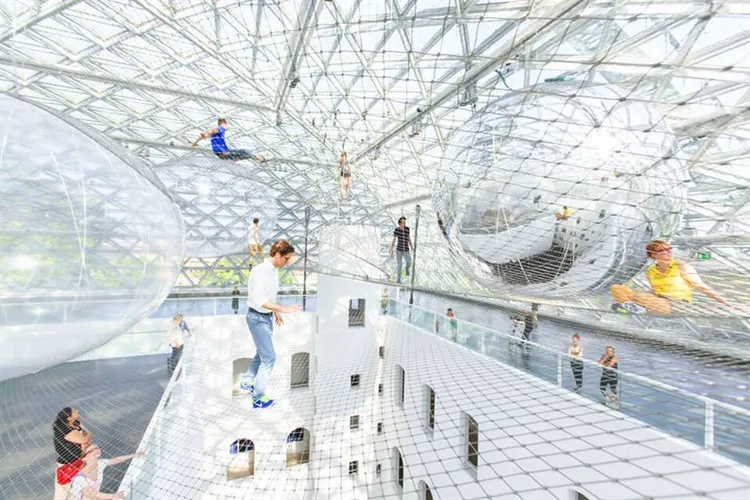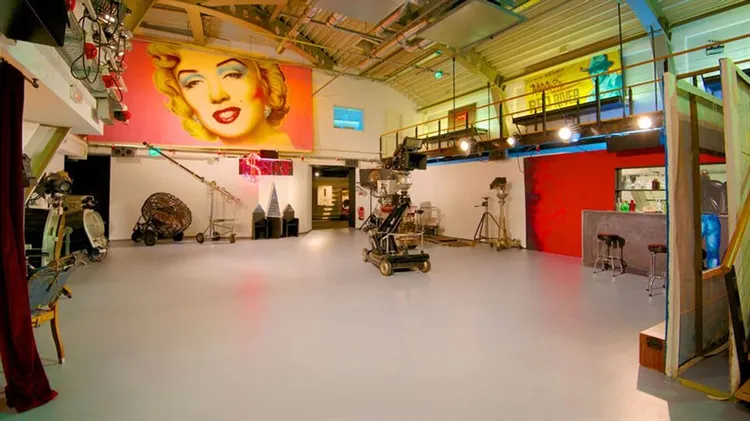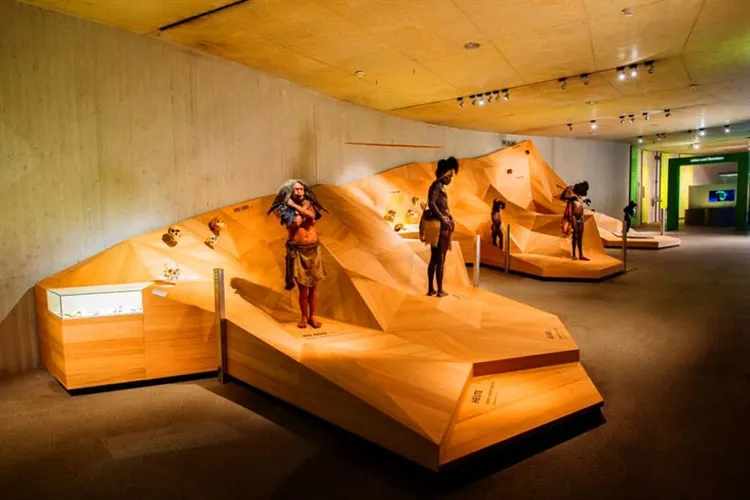The concentration of historical sites in the central part of the capital of the federal state of Rhine-Westphalia rolls over. The sights of Dusseldorf, in addition to palaces, castles, ponds and alleys, include ultra-modern skyscrapers, multifunctional leisure centers, performance galleries, and concert halls. Düsseldorf's 80 design offices compete with each other to improve the metropolis, a city highly attractive to tourists, although the population density here is one of the highest in Europe. What was lost during the Second World War is being restored bit by bit. On the site of the former ruins, futuristic buildings are growing, organically inscribed in the preserved pre-war buildings.
Old Town – Altstadt
The historical center is bounded on the northeast side by Heinrich Heine Alley. The museum of another great poet – the author of “Faust” by Johann Wolffang Goethe – is also here: in the extreme southeastern point of Allstadt. The northwestern border is marked by the dome of the Tonhalle concert hall. It is clearly visible if you stand on the embankment near the entrance to the underground KIT gallery.
🏨 🚕 Individual transfer from the airport to the hotel and more
Among the numerous boutiques, nightclubs and restaurants, spiritual centers are not lost: the Art Academy, the Seminary of St. Ursula, the Art Collection of North Westphalia (located in 3 separate buildings), the only Ceramics Museum in Germany and the extensive exposition of the Film Museum with an area of 2.200 m². These attractions are close to the Historic Stadtmuseum. The path to them runs along the Catholic Church of St. Maximilian.
In Allstadt, you can visit the fortifications of the Electors of Westphalia: the Kaiser's fortress, Helltorf and Kalkum. The last two have been preserved in their original form. Having achieved a position, the winners built palaces and temples. Before the war, there were about a hundred churches, Orthodox churches and synagogues in the city with an area of 4.5 km². The existing churches, with their interior decoration, demonstrate the wealth of the medieval capital of North Rhine-Westphalia.
Burgplatz square
On the way to the square Burgplatz meets the “Green Matilda”. This is the name of the clock of the New Embankment. The granite pillar at the base of the clock serves as a water gauge. Built “Matilda” in the XIX century. The dominant feature of the square itself is a round tower with an octagonal tent. Exactly the same stood on the surviving foundation before the fire at the end of the 19th century.
This outpost is the last evidence of the greatness of the Düsseldorf castle, built back in 1384 for the dukes of Jülich-Cleve-Berg. The dilapidated walls were demolished to make way for a motorway along the Rhine. Built in 1902, the remake houses the Schlossturm Shipping and Navigation Museum, as well as a sommelier restaurant. Burgplatz is the first step down to the water. Below the square is a multi-kilometer bar counter Längste Theke der Welt.
The second step – Promenade Alley – is the overlap of the route, located underground. The most interesting step is the third one. The seething water of the Düssel River breaks out of concrete pipes and draws whirlwinds, mixing with the Rhine. The confluence is observed from the terrace, which looks like a medieval bastion.
New Customs
American architect Frank Gehry proposed inclined planes for buildings, which residents call dancing or simply Gehry buildings. The dance in white, silver and brown is performed by the buildings of the Neuer Zollhof Media Center. The construction of houses marked the beginning of the so-called architectural zoo. The experimental architecture occupies the place where the customs house stood, therefore there is a third name – the New Customs.
Having spent 60 million euros on the dance of concrete in 1998, the mayor's office continues to amaze. Although the first skyscraper was erected back in 1924 (administrative complex Wilhelm Marx House, 57 m), and it is the first in Germany, they decided not to spoil the landscape, but to improve it. Going deeper into the park of glass and concrete, you can see: the mirrored “City Gates”, the Roggendorf-Haus house with plastic men climbing the facade, the sail of the KAI 10 gallery, 75 m of the “Igla” skyscraper, the patchwork, incredibly colorful “Solitaire”, surprising the curvature of the Alu-Buerodose windows, the driven wedge of the Grand Bateau.
Hop-on Hop-of Bus Tour – 18€
Tourist Card: DüsseldorfCard – 10€
town hall
The old town hall dominates the Marktplatz. It is easy to get here from the embankment if you walk from the Museum of Shipping one block in a northwesterly direction. Rathaus Dusseldorf – U-shaped building in the Gothic style with characteristic gables in the form of tongs, built in 1573. The monument to Elector Johann Wilhelm of the Palatinate (1703-1711) on horseback is a tribute to the recognition and respect of the townspeople for their great ruler. People come here for the Wine Festivals in September and for the December Christmas Markets.
The town hall was designed by the architect Alexandro Pasqualini. The name of the builder has survived: Heinrich Tuschmann from Duisburg. The dominant feature of the five-story pink-brick façade is a tower with a pointed tent. There is a ladder inside the tower. For a long time it served as the main entrance to the town hall. The first floor was occupied by workshops and warehouses of artisans. Here the goods were sold. One of the outbuildings was occupied by an art gallery. The original appearance of the main wing was changed slightly: the facade was supplemented with a new central entrance, it is next to the tower one.
The third wing was occupied by the School of Applied Arts for a long time, but the magistracy of the big city needed new premises. In 1883, a Renaissance-style brick city government building stretched along the embankment, absorbing the old branch. The yellow brick building with carved stone decorations was designed by Eberhard Westhoffen. The gallery with portraits of Dusseldorf celebrities in the town hall building is open: Mon – Thu from 8.00 to 17.00 and Fri from 8.00 to 16.00.
Basilica of Saint Lambert
The basilica stands on the site of a wooden church from the 8th century. From the structure of the beginning of the Christianization of the population near the river. Düssel has survived to this day, except for the name: it was consecrated in honor of St. Lambert, a German missionary who became Bishop of Maastricht. The village church was erected on the site of the chapel in the 13th century. It began to grow, transformed into a monastery. It received the status of a monastery after the Battle of Worringen in 1288.
Count Adolf V von Berg and Count Ebergard von der Mark, in alliance with the Cologne townspeople and peasants of Düssel, in the fight against Archbishop Siegfried of Westerburg, defended the right to mint coins and the city status of Düsseldorf in the course of swift, successful hostilities. The capitulation letter signed on August 14, 1288 by the Archbishop of Cologne gave impetus to the development of a new city on the banks of the Rhine. Grateful von Berg donated huge amounts of money to the monastery. But the church acquired its current appearance, thanks to another duke – Wilhelm I. He decided to make Düsseldorf the center of his possessions.
The basilica built under him was called the Church of Our Lady. The name did not take root, it was consecrated again in 1805, giving the papal title of a minor basilica (1974). Thus, the oldest building became a symbol of its independence. The upturned spire with a displaced axis exalts the feat of the Virgin Mary. Twisting is characteristic of the rose, the symbol of the Mother of God. Rose petals are depicted on stained glass windows.
Church of the Apostle Andrew
If you go from Burgplatz deep into the Old Town along the street. Kurze StaYae and walk one block – on the next street AndreasstraYe you will see a church built in honor of St. Andrew the First-Called. The baroque building, erected in 1629, is the tomb of Johann Wilhelm of the Palatinate, treasurer of the Holy Roman Empire, who has been resting here since June 8, 1716. It is his sculptural portrait on horseback that stands in front of the town hall.
In 1629 the new church was consecrated to the Order of the Jesuits. In 1717, the tomb of the Electors of the Palatinate was added to the building, and after the dissolution of the Order by Pope Clement XIV in 1773, the church became a parish. Since 2005, Andreaskirche has been owned by the Dominican Order. Inside, sculptural portraits of the 12 apostles have been preserved. The altar was badly damaged during the war, but in 1960 it was re-carved from marble by the sculptor Ewald Matare. The age of the organ starts from 1782. Created by craftsmen Peter Kemper, Bernhard Orlinski and Josef Zimmermann, it was based on an electro-mechanical tractor in 1900. The next restoration took place in 1971.
Tonhalle Concert Hall
The world‘s largest planetarium was built in 1926. A stadium-like building with gothic windows stands next to the Hofgarten park. Everyone who wants to see the “colosseum of the 20th century” is taken by light rail to the stop “Tonhalle/Ehrenhof”. The flow of those wishing to get inside does not decrease, because the Tonhalle was converted into a concert hall in the 1970s. Now the stars do not move around the dome – they stand on the stage. The hall hospitably welcomes opera singers, jazzmen, rock musicians and symphony orchestras, even organists: an organ of the latest system has been installed.
The enchanting performances of the stars intensified after the reconstruction in 2005. Light-emitting diodes, voluminous scenery, comfortable seats in the auditorium attract listeners, despite the high ticket prices.
Place on the “gallery” is approx. 150€, balcony – 210€, in the stalls – up to 325€. The beginning of performances, concerts at 15:00, 17:00, 18:30, 19:00, 19:30 and 20 hours.
Museum of the Kunstpalast
It is located on Heine Allee, opposite the Grabbeplast square. Well recognizable by the ‘Egyptian' style façade with an abstract wire sculpture in the center of the pool. The art of the 20th century is presented in this gallery. The exposition is announced as Kunst des 20. The other two branches are the K21 gallery in the Ständehaus mansion on the shore of the Kaiserteich lake (given to works of modern times, that is, belonging to the 21st century). Part of K21 is placed in the halls of the gallery Schmela Haus.
Built in 1971, the building in the form of an evolving ribbon is called the “exhibition space” and is the first specialized exhibition building in Germany. Located one block south of K20. In K20 itself, the designer restaurant Klee is open. The great abstract artist Paul Klee taught at the Dusseldorf Art Academy for 20 years, and therefore left hundreds of wonderful paintings and art objects in his hometown.
The complex is open from Tuesday to Sunday from 11 am to 6 pm, on Thursday it closes three hours later.
Goethe Museum
Goethe-mania began during the lifetime of the great German poet, philosopher, geologist and botanist. Collector Anton Kippenberg, who collected a huge amount of personal items, manuscripts, folios, did not have time to create a worthy repository for priceless rarities, but bequeathed the business to his daughter. When the question arose about the city for the museum, a competition was announced. Weimar and Frankfurt fell out of the list of applicants: Goethe's museums already existed there.
In 1987, the exposition opened in the Jägerhof castle, built in the rococo style. In 1772 the castle belonged to Elector Karl Theodor. The Dutch park with flower fields around the castle was equipped, keeping the branch of the river. Dussel. The castle was renovated before Napoleon visited the city in 1811. Although since the 18th century the castle was often in disrepair, it was repeatedly looted, many authentic things were returned. They create the entourage of Goethe's time with furniture sets, sheet music, porcelain and paintings. The exposition includes a philatelic collection of 35,000 coins. The museum has a library and a reading room. The entrance to the Royal Park is through the Goethe restaurant.
Tue – Fri, Sunday: from 11:00 to 17:00, Saturday – from 13:00 to 17:00.
Benrath Palace
The luxury of the elector's courts can be judged by the Benrath Palace. Located in the district of the same name, a complex of 2-3-storey buildings is located around an artificial reservoir. The park area is adjacent to the Rhine. The style of the palace is rococo. The oval windows with curvilinear shutters, the magnificent dome of the central hall, the octagonal offices and front rooms are richly decorated with polished marble details between pilasters and sculptures. Benrath opened in 1929 to the public as a museum.
Benrath was built for the Palatinate Elector of Bavaria Karl Theodor in 1723-1796. under the direction of the architect Nicolas de Pigage. Houses for servants, guests and retinues (cavalry houses) are divided into separate outbuildings and built around the lake in the form of a horseshoe. They were completed in the “classicism” style.
Dishes were served from the kitchen through an underground tunnel. The park is equipped with additional buildings – greenhouses, in which exotic plants “winter”. The greenhouses function to this day; in 2000, the Museum of Park Art was opened on their basis.
Benrath Palace also houses the Natural History Museum. Sightseeing tours in the palace are held at intervals of 1 hour in summer: from April 1 to October 31, and in winter: from October 1 to March 31 – every day, except Monday, from 11 am to 5 pm. On Saturdays and Sundays in summer, Benrath Castle is open until 18:00.
Helltorf Castle
3 km north of the district of Allstadt on the territory of Angermund, it is worth visiting the castle Heltorf (Schloss Heltorf), preserved from the 19th century in its original form. Defensive structures: a moat, a bridge, watchtowers and fortress walls date back to the 14th-16th centuries. The palace is still inhabited by the descendants of Count von Spee and is closed to the public. But anyone can enjoy the English park laid out in 1796 (54 hectares).
In the park there is a summer pavilion with frescoes by Karl Mücke (1830s): “Reconciliation of Frederick and the Pope in Venice“, “Humiliation of the inhabitants of Milan”, “Coronation of Frederick I” – which are also available for free viewing. Open only in summer, on weekends (Sat, Sun) and public holidays.
Kalkum Castle
A visit to the park area around Kalkum Castle (next to the International Airport) will leave a deep impression. It is pleasant to wander through the preserved forest of the 16th century with hunting lodges and shady alleys. The castle itself with three entrance towers, hipped ceilings, narrow loopholes and a moat at the base of the defensive walls is municipal property.
Used as an administrative building and restoration workshops. Style – “Neapolitan Baroque”. One of the pavilions is occupied by the memorial of the philosopher Ferdinand Lassalle.
Imperial Palace in Kaiserswerth
The ruins of the imperial palace can tell a lot about themselves, but the details will be explained in the Kaiserswerth Museum. Fragments of the 6-meter masonry of the defensive walls, the foundations of the northern and southern parts of the palace, traces of a large hall, the foundation of a donjon with walls up to 4.5 meters thick and a cistern that goes underground for 13 meters to collect rainwater in case of sieges have been preserved. Eight meters of the catchment rises above the surface.
On the banks of the Rhine they fought thousands of years before the rise of the United Germany, they fought with their neighbors, they fought among themselves. Remains of Neanderthals were found near Düsseldorf (the very first find of a primitive man was found here). Then the militant Cro-Magnons came to the Rhine, displacing and exterminating their competitors. In incessant battles, the next (after Charlemagne and the Ottons) Great Emperor of the Roman Empire of the German nation Henry II gained power.
Henry II of Bavaria – Duke, after the canonization began to be called the Saint. The Bavarian who became king (1002) expanded his possessions, united counties and abbeys under his command, fought with the Poles, Czechs and Byzantium. The power-hungry Henry was crowned as the Anointed of God in 1018, after which all the German lands became part of a large state – from the Mediterranean to the North Seas. Before the unification, the Kaiserswerth Palace was mentioned in chronicles only in 1016. The mention occurred in connection with the transfer of the castle to Ezzo of Lorraine.
A generous gift, considering that the Emperor, the former duke of Bavaria, reclaimed his personal lands around Kaiserswerth, as illegally taken from him by the abbots of Cologne. The palace and castle Kaiserswerth became a kind of payment to the applicant from the Ottonian dynasty for withdrawing the claim to the imperial title. In 1062, the castle was captured by Archbishop Anno II. Three years later, Kaiserswerth was recaptured by Henry IV. A hundred years later, Frederick Barbarossky erects a new castle on the site of the old one. After surviving four sieges, the castle is destroyed by the combined forces of Brandenburg, the Netherlands and England.
In 1899, the excavations were led by Paul Klemen. Findings accompanying the excavations are exhibited in the Castle
Museum. The museum is open on Saturdays from 14.00 to 17.00 and on Sunday from 11.00 to 13.00, then from 14.00 to 17.00.
Reinturm tower
At the end of 1978, the question arose of the need for a radio and television broadcast tower in Düsseldorf. The winner of the competition was a 240-meter tower made of monolithic two-layer reinforced concrete by architect Harald Deilmann. By moving the formwork on jacks, the shaft of two suction cylinders for the future Rheinturm was raised to a mark of 219 m. Construction continued with the construction of a basket with a diameter of 35.5 m. The technology is unique and applied for the first time.
4 elevators are used to lift tourists to the observation deck. Completed in 1981, the “onion” Rheinturm is visited annually by more than 300 thousand tourists. The observation deck is open from Sunday to Thursday – from 10.00 to 24.00, and on Friday and Saturday – from 10.00 to 01.00.
Get by trams No. 704, 709 and 719 to the stop Landtag / Kniebrücke or bus number 725.
royal alley
The Old City is separated from the New City by the Royal Alley. It is planted on both sides with chestnut trees, which have grown together with crowns and turned into a green tunnel. Here is the shopping street Schadowstrasse with incredibly expensive, but very fashionable boutiques, luxurious restaurants, cafes. In one of the buildings, the experimental theater group JuTA shows neo-art performances.
A decorative canal with narrow bridges without railings stretches along the alley. The waters of the canal originate from the gushing jets of the sculptural composition “Young Triton and Putti-Cherubs” (1900) by Friedrich Kubilier.
Hofgarten park
From the northeast, the Altstadt frames the Hofgarten park, laid out in 1557-1769. From the very beginning, the green zone was organized as a place of rest for the townspeople without charging any fee. The initiative is the first of its kind in Germany. Alleys and fountains, sculptural groups, the landscaped shore of Lake Landskrone at the northern point of the Jagerhof castle and the Neanderthal Museum. Favorite places for tourists to take a selfie are the composition “Children look at a frog”, a monument to the painter Peter Cornelius at the entrance, the marble “Fallen Warrior”, “Bronze Baronesses”.
Rhine embankment
The embankment of the Old Town of Altstadt becomes a Promenade already during the reign of Duke Johann Wilhelm after his marriage to Jacobina of Baden in 1595. The castle and approaches to it are under construction. The demand for the aesthetic appearance of the city led to the creation in 1821 of the Academy of Arts, which until the beginning of the 20th century was located within the walls of the Düsseldorf castle. The adjoining part of the embankment here is called the Castle.
To the north is part of Tonhalle. To the south – Burgplatz and the Town Hall. Even further upstream is a section named after the Mannesmannufer skyscraper. Next – Apolloplatz and the Platz des Landtags. Opened in 1993, the Rhine Tunnel now serves the B1. New opportunities were used by talented architects Niklaus Fritschi, Benedikt Stahl and Günter Baum. For work on the improvement of the embankment in 1995 – 1997. German Union. architects awarded the first prize to the trio of authors for the skillful transformation of leisure places.
The glass dome of the KIT gallery functions as a restaurant in the evening. The exposition itself is open to the public from 11 a.m. to 6 p.m.
Church of St Swithbert
One of the most notable Catholic shrines is the Church of St. Switbert in the historic district of Kaiserwerth (translated as “imperial island“). It was a reclaimed island in a branch of the Rhine. At this point, the old Roman road and the main trade route of the Middle Ages intersected. Not so long ago, the object acquired the status of a protected architectural monument.
The history of the religious building dates back to the year 700 – St. Svitbert founded a monastery on the donated lands. In the middle of the 2nd century, a three-aisled basilica in the old Romanesque style was built on the territory of the monastery chapel, and later an extension appeared in the style of the Gothic choirs. The relics of Saint Swithbert were transferred to the church. The gilded oak Reliquary is one of the few treasuries of this type that have survived to this day.
The area was repeatedly destroyed and devastated. In the 8th century it was the Saxons, in the 9th century the Normans attacked. In 1870, a large-scale reconstruction was carried out here with an extension, 4 towers were added. The Second World War brought bombardments, after which it was necessary to restore the surviving part. Today it has the title of “Small Papal Basilica” with luxurious stained glass windows and a unique organ.
Japanese garden
The Japanese Garden (Japanese Garden) is beautiful at any time of the year, but the spring cherry blossoms and azaleas give it a special charm. The city authorities decided to ennoble this park place in the best Asian traditions in 1975, but the initiative came from the Japanese community. The general plan and the delivery of rare seedlings were supervised by the Japanese Garden Society at the Dusseldorf Chamber of Commerce and Industry.
The development of the project was entrusted to the Japanese architect Iwakii Ishiguro, he was assisted by his son Shojiro and 6 other Japanese landscape designers. Japanese Ambassador to Germany Akiro Sonno was invited to the opening ceremony of the garden. Every 5 years, an inspection from the country of the Rising Sun comes here. The main care for the park area on 5 hectares is carried out by a group of local gardeners trained in the secrets of fine craftsmanship. You can visit the Japanese Garden on your own or with a personal guide who will tell you a lot of interesting things.
Aqua Zoo and Loebecke Museum
In the southern part of the city there is a place that is mentioned not only in the list of city attractions, but also on the list of unique places in Germany. Aquazoo Löbbecke Museum is a local history museum of natural history combined with a zoo, an aquarium, a scientific base and other facilities.
Initially, there was only a zoo, opened in 1876 by the zoologist Alfred Brehm. Even in those days, his desire was to present to visitors the life of animals in open enclosures, as close to natural conditions as possible. According to his plan, it was a green zone or a kind of “oasis” for expanding knowledge of botany and zoology.
Today it is a unique object of great interest to visitors with children. Properly designed squares with rare trees and a beautiful recreation area, a system of united ponds, a network of restaurants and playgrounds. Although this is not the largest zoo in Germany or Europe, but the place with an area of over 13 hectares impresses with its organic nature and closeness to nature.
Grafenberg Wildlife Park
The Grafenberg Forest has a lot to offer for family tourists with children who want to get to know the habits of animals better. It is noteworthy that this is a free zoo, conceived as a Wildlife Park. In the forest area of the Grafenberger Wildpark you can meet typical representatives of the European fauna.
Deer and roe deer, musk deer and mouflon, ferrets and raccoons go about their business in the thickets or their own houses. Sometimes pheasants and partridges come out closer to visitors. Wild predators are separated by a grid of enclosures – these are wild cats and wild boars, foxes and wolves.
The forest area of about 40 hectares is part of the Aaper conservation area from Duisburg to Hilden, so there is enough space for all animals. The Wildpark in Grafenberg was founded back in 1927; patches of relic beech forest have been preserved here. Today you don't have to travel far – it's just a few minutes walk from the city tram line.
north park
Of the numerous green areas of Düsseldorf, the Nordpark is considered the most convenient in terms of location and well-maintained. Therefore, in tourist guides it is listed as “the most visited”, the construction of which began in 1936. The territory of the Northern Park covers an area of more than 36 hectares, this is in the Shtokum region.
During the reign of the National Socialists, it was prepared as an exhibition platform to demonstrate the achievements of the Third Reich “Working People”. It was planned to equip it in an industrial area similar to the Soviet VDNKh. But the Reichsausstellung “Schaffendes Volk”, which attracted millions of visitors, did not last long due to the events of World War II.
Most of the monuments and sculptural compositions fell into disrepair, becoming the territory captured by the British. Then the North Park passed into the city administration, having undergone significant reconstruction. Today, part of it has been given to the Japanese Garden, part to Aquazoo and the Museum of Natural History. There is a huge pond, many fountains, flower galleries and many picturesque corners.
Museum of Contemporary Art “K21”
For unprepared visitors, some of the exhibits are a “culture shock”, although this is just the Museum of Contemporary Art of the 21st century. It has been in operation since April 2002 and is part of the Art Collection of North Rhine-Westphalia. The building of the Kunstsammlung Nordrhein-Westfalen exposition in itself is the pinnacle of architectural thought in the best traditions of the Millennium.
The museum under a glass dome gives a feeling of unlimited space. Its unique shape, inimitable view from the windows and stunning fusion with the local landscape can inspire painting. In terms of style, this is the most eclectic building in Düsseldorf, where classics and modern urbanism are combined.
It cannot be said about the exposition that it is designed to please every tourist, but there is something to think about here. It is difficult to say something definite about many works, but many visitors say that they would not have thought of such a thing. Perhaps this is the beauty of progressive art in the 21st century.
Cinema Museum
There are not many museums on the planet dedicated to the history of cinema. The local exposition is no less interesting than the Hollywood or Japanese ones. Here, on the Rhine embankment, the German state collection is kept, opened to visitors in 1993. The three-story Art Nouveau building is solid concrete, brick and glass, but it looks very attractive.
It has always been interesting for people to look behind the scenes or the screen, to find out the whole “kitchen” of the cinema world. However, free admission is only for children, but it is easy to feel like a child who has discovered the world of parallel reality. There are even a few objects that even preschoolers react very emotionally to.
Each floor is a separate theme. The first is a collection of costumes of familiar “movie” characters, photos and movie posters from film sets. The exhibition on the second floor is the history of cinema in development, including primitive vehicles with a camera and modern equipment for special effects. The third level is a real film set, where everything is frozen in anticipation of the command “motor!” The fourth floor is preparatory work, where screenwriters, make-up artists, costume designers and decorators are involved.
Neanderthal Museum
It is considered the most visited attraction in Germany, located on the periphery – at least 170 thousand visitors annually. Its exposition is devoted to archaeological excavations, but in these picturesque places it is just nice to take a walk and breathe in the fresh air, filled with the smells of a virgin forest. For lovers of hiking, several exciting routes have been developed here.
In 1856, the German naturalist J.K. In the Feldhof cave, a group of archaeologists under his leadership found a Homo sapiens site and the remains of an ancient man. Soon the found species acquired a name for this area. Since then, the world has known about “homo neanderthalensis” or Neanderthal man.
The most interesting exhibits recreate the details of the life of primitive people. Modern technologies are involved to give realism to imitation of the cave. The museum is interesting not only for adults, but also for children and teenagers. The exposition is located in a modern building, but everything works to create a “primitive” atmosphere, even the wax figure of a good-natured Neanderthal at the entrance.
